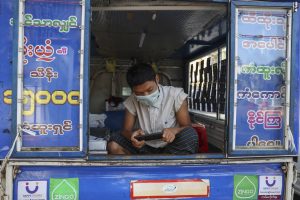On March 23, Myanmar recorded its first cases of COVID-19, thereby ending its dubious title as the most populous country yet to report any infections. For the developing nation’s 54 million people, the confirmation is certain to raise alarm. Ever since the outbreak began in China — which shares a 2,227-kilometer porous border with Myanmar — medical experts and rights groups have been urging the government to prepare for the worst.
Despite its recent rapid economic growth, the country is particularly vulnerable to the pandemic. Aside from its proximity to the outbreak’s epicenter, Myanmar borders Thailand, Bangladesh, and India, where cases have been on the rise. Meanwhile healthcare remains underdeveloped with the government, led by Aung San Suu Kyi, struggling to modernize public services after decades of military rule.
At the heart of the concerns about Myanmar’s exposure lies doubt over the veracity of the official count of zero cases until last week. Government spokesman Zaw Htay claimed the national “lifestyle and diet” was the reason Myanmar had yet to see a COVID-19 case, among other outlandish theories.
The country has tested over 300 people since the start of the outbreak — not enough, according to some doctors. To add to the current handful of positive cases, some posit that a significant number of infections may be going undetected, particularly amid the rapid return of migrant workers back into the country from Thailand, China, and Laos. Meanwhile, others suspect a cover-up.
Either way, the government will know from observation elsewhere just how rapidly a smattering of cases can multiply into hundreds. The country’s densely populated commercial center, Yangon, and its ethnic hinterlands, where there is ongoing conflict, poorer sanitation, and lower levels of awareness, will be particularly susceptible areas.
Officials will also have seen just how quickly economies can stutter to a halt. Indeed, poverty also makes Myanmar particularly vulnerable. Factory closures have already led to job losses, while many working in the large informal sector as vendors and artisans will be concerned at the prospect of widespread isolation measures across the country. Few will have savings, insurance, or a social safety net to rely on. The loan support and tax payment deferrals currently on offer for registered businesses will do little to help them.
In terms of the public health response, the limited capacity of the country’s healthcare system, which is already propped up by aid groups, will be the prime concern. Myanmar is one of Southeast Asia’s lowest per capita spenders in this area. A study in late 2016 also found 13 out of 15 states and regions in Myanmar had below the World Health Organization’s recommended minimum number of one doctor per 1,000 people.
When Suu Kyi’s party, the National League for Democracy, stormed to its election victory in 2015, it did so on a manifesto pledge to develop a universal healthcare system. Decades of underinvestment and mismanagement led to widespread disparities in services, and out-of-pocket payments for health as a proportion of total health spending are among the highest in the world — which is particularly problematic when 1 in 4 live in poverty.
Momentum on healthcare policy has slowed. An upsurge in ethnic conflict, including international condemnation over the military’s deadly crackdown on the country’s Rohingya Muslims, has stalled much of the NLD’s agenda since it came to power. “Hundreds of thousands of people in disadvantaged communities have little or no affordable access to government-supported health services,” noted a recent NGO review of the country’s public health agenda.
The government has nonetheless been taking other precautions to slow the spread of COVID-19. Public gatherings, including the annual Thingyan Buddhist New Year celebrations, have been banned. The government also ordered mandatory quarantines for travelers entering the country, shuttered land borders to foreigners, and started to raise money from the public to support its response. Schools, colleges, and universities have also been closed.
The general sense among public health experts is that the state still hasn’t raised enough alarm. Building an effective public campaign against the virus, while avoiding mass panic, will be a challenge for Suu Kyi’s still inexperienced government. The potential for fake news to spread on social media could stoke hysteria, just as it fueled ethnic violence already in the country, which could further undermine already mistrusted state communications. Meanwhile, the military’s control over the defense, border, and home affairs portfolios could further complicate coordinating the response.
Suu Kyi made a televised address to the nation on Tuesday, appealing for calm and urging citizens to follow the Health Ministry’s guidelines. But despite her words the state counsellor must know the country will come under severe strain. The government has been stockpiling donations of test kits and temporary quarantine sites have sprung up. Yet doctors across the country remain anxious about the slow response to ramp-up testing facilities and access to personal protection equipment.
As the virus has spread through China, Europe, and the United States it has battered health services and bruised economies, but for even more vulnerable and unprepared developing nations like Myanmar, it could be much worse.
Tej Parikh is a global policy analyst and journalist. He was an associate editor and reporter at The Cambodia Daily in 2015-16. He tweets @tejparikh90 and his work is archived at The Global Prism.

































